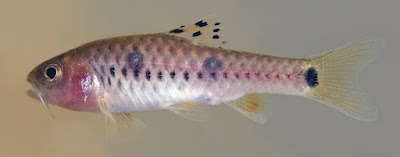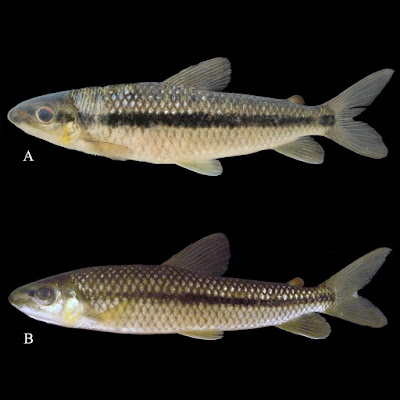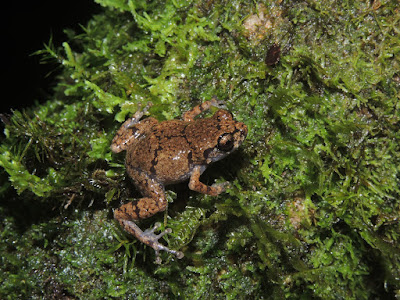[Most Recent Entries] [Calendar View]
Wednesday, July 3rd, 2019
| Time | Event | ||
| 9:05a | [Ichthyology • 2019] Enteromius pinnimaculatus • A New Species of Enteromius (Cypriniformes: Cyprinidae) from southern Gabon Abstract We present and describe a new species of Enteromius, adding to the 16 species of Enteromius currently recorded from Gabon, West Africa. This new species is distinguished from all other Gabonese Enteromius by the presence of several distinct spots on the dorsal fin in combination with three or four round spots on the flanks. In Africa, it is superficially similar to Enteromius walkeri and with which it shares an unusual allometry in that the proportional length of the barbels decreases as the fish grows. Nevertheless, one can distinguish these species by vertebral number, maximum standard length, the length of the anterior barbels, the length of the caudal peduncle and in most specimens, the number of lateral‐line and circumpeduncular scales. These two species also inhabit widely separated drainages, with E. walkeri occurring in coastal drainages of Ghana including the Pra and Ankobra Rivers and the new species occurring in tributaries of the Louetsi and Bibaka Rivers of Gabon, which are part of the Ogowe and Nyanga drainages, respectively. Despite extensive collections in those drainages the new species is known from only two localities, suggesting the importance of conservation of its known habitat. Keywords: allometry, biodiversity, central Africa, conservation, endemic, morphometrics, systematics
Enteromius pinnimaculatus sp. nov. Etymology: The specific epithet pinnimaculatus refers to the multiple small dark spots on the dorsal fin, which is a rare characteristic within Enteromius. An adjective in the nominative singular. Hans Kevin Mipounga, Joseph Cutler, Jean Hervé Mve Beh, Benjamin Adam and Brian L. Sidlauskas. 2019. Enteromius pinnimaculatus sp. nov. (Cypriniformes: Cyprinidae) from southern Gabon. Journal of Fish Biology. DOI: 10.1111/jfb.13995 | ||
| 9:14a | [Botany • 2019] Etlingera mamasarum • An Update of the Genus Etlingera (Zingiberaceae) in Sulawesi including the Description of A New Species
Abstract A new species, Etlingera mamasarum A.D.Poulsen & Ardiyani was discovered in Gunung Gandangdewata National Park, West Sulawesi. It is similar to Etlingera flexuosa A.D.Poulsen but differs in having flowers which are shorter than the bracts. It is described, illustrated and DNA barcoded. Three additional species (Etlingera cylindrica A.D.Poulsen, E. grallata A.D.Poulsen, E. spinulosa A. D.Poulsen) were documented in this national park and represent new records for West Sulawesi Province. We also update information on the morphology of E. calobates A.D.Poulsen, correct an error in the typification of Alpinia chrysogynia (K.Schum.) K.Schum. and discuss the distribution of the Achasma Group of Etlingera east of Wallace’s Line. Keywords: DNA barcoding, Etlingera calobates, E. mamasensium, E. megalocheilos, Indonesia, Zingiberales. Etlingera mamasarum A.D.Poulsen & Ardiyani, spec. nov. Type: Indonesia, West Sulawesi Province, Mamasa, Rantepongko Village, Gunung Gandangdewata, ..., 1,642 m, flowering and fruiting, 21 April 2016, M. Ardiyani with W. Santoso, Obet, Ama, A. Kartonegoro, D. Wulansari Sulbar 004 (Holotype: BO!; iso E!), Fig. 1, 2 & 3. DNA barcoding in Table 2. Diagnosis. Similar to Etlingera flexuosa A.D. Poulsen but differs in the length of the flowers which are shorter than the bracts, the longer petiole (45–55 mm in E. mamasarum vs 10–40 mm in E. flexuosa), the length to width ratio of the lamina (3.5–4 vs 4.2–5.6), the shape of the base of the lamina (rounded to cordate vs cuneate to auriculate), the size of the fertile bract (5.5−7 × 2.5−3.3 cm vs 2–5 × 0.6–2.5 cm), the position of the pedicel (4 mm stalk above the bracteole vs 1–4 mm below bracteole), the longer bracteole (3.6 cm vs 1.7–3 cm), the apices of the calyx spreading laterally to opposite sides of the flower (vs pointed straight forward), and the shape and size of the labellum (unevenly panduriform, 20–21 × 16 mm vs ovate, 17–22 × 14–20 mm). Distribution. So far known only from the type locality at Gunung Gandangdewata. Habitat & Ecology. Grows in primary forest on a moderate slope not far from river at about 1,700 m. Etymology. The epithet honours the people of Mamasa, West Sulawesi, where the new species was found. Local name & uses. Katimbang (Mamasa language), fruits are eaten. Marlina Ardiyani and Axel Dalberg Poulsen. 2019. An Update of the Genus Etlingera (Zingiberaceae) in Sulawesi including the Description of A New Species. Reinwardtia. 18(1); 49–60. DOI: 10.14203/reinwardtia.v18i1.3729 Jenis baru Etlingera mamasarum A.D.Poulsen & Ardiyani telah ditemukan di Taman Nasional Gunung Gandangdewata, Sulawesi Barat. Jenis baru ini mirip dengan Etlingera flexuosa A.D.Poulsen tetapi berbeda dalam karakter bunga yang lebih pendek dari braktea. Jenis baru tersebut dipertelakan, diilustrasikan dan dilakukan barkoding DNA. Tiga jenis lainnya (Etlingera cylindrica A.D.Poulsen, E. grallata A.D.Poulsen, E. spinulosa A.D.Poulsen) telah didokumentasikan dan merupakan rekaman baru untuk provinsi Sulawesi Barat. Informasi morfologi E. calobates A.D.Poulsen telah diperbaharui, kesalahan tipifikasi Alpinia chrysogynia (K.Schum.) K.Schum. telah dikoreksi dan informasi persebaran E. megalocheilos (Griff.) A.D.Poulsen di timur garis Wallace didiskusikan dalam tulisan ini. Kata Kunci: Barkoding DNA, Etlingera calobates, E. mamasarum, E. megalocheilos, Indonesia, Zingiberales. | ||
| 9:24a | [Herpetology • 2019] Norops brianjuliani • A New Species of Anole (Dactyloidae: Norops) from the Sierra Madre del Sur in Guerrero, Mexico
We describe the new species Norops brianjuliani sp. nov. from the Pacific versant of southern Mexico. Norops brianjuliani differs from all congeners by having a combination of (1) smooth ventral scales; (2) usually a patch of three greatly enlarged supraocular scales; (3) moderately long hind legs, longest toe of adpressed hind leg reaching to a point between posterior and anterior levels of eye, ratio shank length/snout–vent length 0.24–0.26; (4) a pair of greatly enlarged postcloacal scales in males; (5) 10 to 12 rows of greatly enlarged, keeled middorsal scales; and (6) a very large pink dewlap in males. In external morphology, N. brianjuliani is most similar to N. liogaster from which it differs by having larger middorsal scales (more than three times the size of granular flank scales in N. brianjuliani vs. less than three times in N. liogaster). Also, in a preliminary molecular genetic analysis, N. brianjuliani has a genetic distance of 8.7% (16S) and 15.3% (COI), respectively, from N. liogaster. Key words: Norops brianjuliani sp. nov.; Dactyloidae; Guerrero; Mexico; new species; Reptilia; Squamata. Norops brianjuliani sp. nov. Gunther Köhler, Claus Bo P. Petersen and Fausto R. Méndez de la Cruz. 2019. A New Species of Anole from the Sierra Madre del Sur in Guerrero, Mexico (Reptilia, Squamata, Dactyloidae: Norops). VERTEBRATE ZOOLOGY. 69(2); 145-160. DOI: 10.26049/VZ69-2-2019-02 | ||
| 9:30a | [Ichthyology • 2019] Leporinus sidlauskasi • A New Species of Leporinus (Characiformes: Anostomidae) from the Rio Tapajós basin, Brazil
Abstract A new species of Leporinus is described from the rio Teles Pires, rio Tapajós basin, Amazon basin, Brazil. The new species is diagnosed based on dental formula 3/4, a dark midlateral stripe on body and a series of transversal dark bars on the dorsum. The new species is similar to a handful of congeners based on the color pattern, including L. britski, L. microphysus, L. parvulus, and L. vanzoi, all of which also occur at the rio Tapajós basin. The new species is distinguished from the aforementioned congeners based on number of premaxillary teeth, number of scales in lateral line and/or around caudal peduncle. The new species is apparently endemic to the rio Teles Pires near the Sete Quedas rapids and upstream. Keywords: Leporinus vanzoi, Taxonomy, Anostomoidea, Rio Teles Pires, Pisces  Leporinus sidlauskasi sp. nov. Heraldo A. Britski and José L. Birindelli. 2019. Description of A New Species of Leporinus (Characiformes: Anostomidae) from the Rio Tapajós basin, Brazil. Zootaxa. 4603(1); 183–191. DOI: 10.11646/zootaxa.4603.1.10 New fish discovered in Amazon basin named after Oregon State researcher today.OregonState.edu/news/new-fish-discovered-amazon-bas | ||
| 9:41a | [Herpetology • 2019] Diasporus amirae • A New Species of Dink Frog, Genus Diasporus (Anura: Eleutherodactylidae), from the Caribbean foothills of the Cordillera de Talamanca, Costa Rica
Abstract A new dink frog (Eleutherodactylidae: Diasporus) is described from the Tropical Wet Forest, in the northeastern foothills of Cordillera de Talamanca in Costa Rica at an elevation of ca. 1000 m. Analysis of DNA sequences of the 16S rRNA (16S) and cytochrome oxidase 1 (COI) mitochondrial genes revealed a distinct lineage within the genus Diasporus. Additional morphological, morphometric, and acoustic analyses support the differences of this lineage, which we recognize as a new species. This new taxon is distinguished from other members of the genus Diasporus inhabiting Isthmian Central America by its unique coloration: dorsum brown to brown-grayish and venter gray-bluish with pale blotches. The new species is distinguished from other members of the genus Diasporus by very significant genetic distances (higher than 5.6 % in 16S and 16.7 % in COI). The new taxon is most closely related to D. vocator from the south pacific of Costa Rica and to an unnamed taxon from western Panama. Keywords: Amphibia, Brachycephaloidea, Isthmian Central America, Panama, Taxonomy, Terrarana Erick Arias, Gerardo Chaves, Stanley Salazar, José Andrés Salazar-Zúñiga and Adrián García-Rodríguez. 2019. A New Species of Dink Frog, Genus Diasporus (Anura: Eleutherodactylidae), from the Caribbean foothills of the Cordillera de Talamanca, Costa Rica. Zootaxa. 4609(2); 269–288. DOI: 10.11646/zootaxa.4609.2.4 En Costa Rica, están presentes otras cinco especies del género 'Diasporus' ucr.ac.cr/noticias/2019/06/20/talamanca-l |
| << Previous Day |
2019/07/03 [Calendar] |
Next Day >> |
























